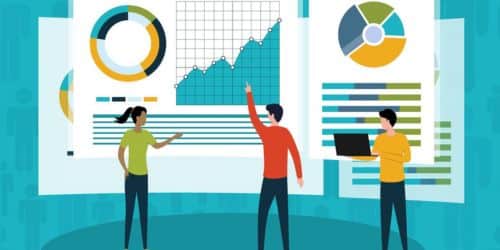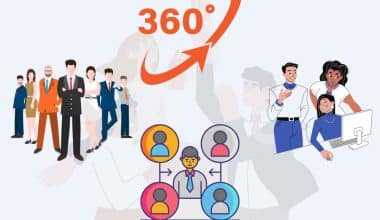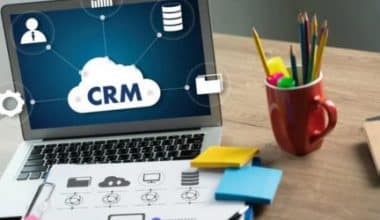People analytics can unlock the actual potential of your staff in a data-driven environment. It is a means of evaluating all people processes, functions, issues, and possibilities at work in order to elevate these systems and achieve long-term company success. According to recent Deloitte research, raising job offer acceptance rates, lowering HR assistance tickets, and optimizing remuneration are just a few of the ways that people analytics is soon becoming the new currency of HR. Let’s see what people analytics is all about in this article, with an overview of the job description and salary range of a people analytics specialist.
What Is People Analytics?
People analytics is a data-driven and goal-oriented way of evaluating all people processes, functions, issues, and possibilities at work in order to elevate these systems and achieve long-term economic success.
Another word for People analytics is talent analytics or HR analytics. Essentially, acquiring and evaluating people analytics leads to better decision-making via the use of statistics and other data interpretation tools.
Smarter, more strategic, and data-driven talent decisions are thus closer at hand, and this applies across the employee lifecycle, from better hiring decisions to more effective performance management to improved retention.
People Analytics Process
People analytics is becoming more intuitive and predictive. With that expectation to live up to, the process includes the following steps:
#1. Gather relevant data.
“What data is relevant to our business goals?” is the primary question here. This allows you to save significant resources by focusing on areas that require direct supervision, such as operational duties within the people management spectrum and can result in measurable economic success.
Digging that data may be a waste of time if it does not bring strategic value. Knowing what to concentrate on also aids in the application of the appropriate statistics, data mining, machine learning, survey management, and strategic workforce management technologies.
#2. Experiment, investigate, and enrich
In a busy and visually fragmented market, it is critical to select a people analytics tool by researching the market, playing with many possibilities, and determining which option would best enhance the business. Data mining, data transformation, and data visualization techniques are all available via a user-friendly self-service interface.
Platforms with a wide range of features frequently necessitate a lot of manual manipulation to get critical data, and these aspects can only be validated through rigorous testing.
#3. Prepare an action plan.
Create an action plan after you know what your end goal is, what data is relevant, and what solutions are available (based on a clear pros vs. cons analysis). The application of big data and predictive analytics to talent management, leadership development, and organizational capacities frequently aids in the fine-tuning of the action plan.
Furthermore, having a well-defined plan of action allows for a better understanding of why certain changes are occurring and where the company is headed, which can assist generate more stakeholder support.
#4. Avoid legal pitfalls.
It is critical to ensure that all data is collected in accordance with the law. Have a legal team assess the data source procedures and protocols before you begin the analytics project. It doesn’t stop there.
After the raw data has been collected and processed, the results must be authorized before they can be applied or published. With data protection and privacy laws continually evolving in our digital world, it is vital to stay up to date on developments and double-check legal compliance.
#5. Develop leaner systems.
Regardless of the project’s complexity, the overall strategy that the procedures must follow must be straightforward and lean. The fundamental process of data analysis and interpretation should be simple to apply, update, and read.
Create a simplified intake and design (data collection and analysis design), data cleaning (removing irrelevant or unreliable data), data analysis (quantitative and qualitative exploration), and sharing insights (data interpretation and presentation). This can assist eliminate unneeded difficulties like confusion about the flow of steps, time waste, or repeating of sub-processes that arise with unstandardized process structures, while yet allowing for modifications where appropriate.
The goal is to strike the correct balance between finite moving components (people and the dynamic of the environment) and flexible, adaptable people analytics systems and procedures. When you have the proper team in place with the right skillset, it is easier to streamline the entire process and apply quality controls.
#6. Create a data-driven, measurable HR business plan.
A realistic HR business strategy avoids functional divisions and can seamlessly align talent with the business. Clear KPIs and ROI objectives from people analytics initiatives guarantee that the impact is monitored frequently and transparently. A winning strategy must be supported by data and an effective action plan.
#7. Contact technical assistance.
Today, technology pervades every part of life, especially procedures like people analytics, where a large amount of analytical data must be processed with little or no margin for error. HR IT technologies of the future make real-time data easily available. And this is an opportunity not to be passed up, because agility and real-time intelligence may actually set you apart from the competitors today.
Important People Analytics Trends
Because people analytics is strongly reliant on new data-mining technologies and data-interpretation methodologies, trends in people analytics evolve in tandem. Here are the top trends shaping people analytics and how it interacts with the business. Some trends have a dual loop effect, affecting people analytics and, as a result, all other aspects of HR.
#1. HR is changing what it is and what it does.
People analytics is rapidly transforming how HR functions, affecting how recruitment is handled, how performance is measured, how compensation is planned or growth is plotted, and how learning and retention may be better managed.
According to recent Deloitte research, raising job offer acceptance rates, lowering HR assistance tickets, and optimizing remuneration are just a few of the ways that people analytics is soon becoming the new currency of HR. Furthermore, as HR procedures evolve to meet the needs of the business, people analytics is transitioning from a one-time project to a real-time, easily adaptable instrument from which HR can reap enormous benefits.
#2. HR business interactions are being transformed.
With recent advances in the work ecosystem, the contact between HR and business stakeholders (both internal and external) has also changed. People analytics must evolve to reflect current leadership trends. Transparency is a significant trend forming here, and cognitive insight is critical.
Businesses today must be able to make sense of seemingly unconnected data streams in order to identify meaning, correlation, and possibly even interdependence between one or more aspects in order to better predict and manage work. People analytics has the potential to generate practical recommendations that can aid in strategic planning and execution procedures.
#3. HR-Employee Relationship Transformation
Today’s employees have consumer-level expectations. Organizations are using people analytics to improve the employee experience. Every interaction a candidate or employee has with a company is a data point that may be used to gain fascinating insights. The objective is to improve HR’s interaction with employees in order to enable HR to become and be viewed as more than merely a support role.
#4. Improving the quality of insights
The quality of insights that are expected on a daily basis has altered over the previous few years. People analytics can meet these expectations if two essential factors are prioritized: analytics literacy and data security.
To reduce reliance on technical people and allow for new viewpoints, more employees will need to become analytics literate. As people analytics becomes more common in enterprises, data integrity, and security must be enhanced and maintained for all listening channels and pulse checks.
What is the Job Description Of A People Analytics Specialist?
People analytics specialists use analytical consulting approaches to solve difficulties and shape solutions, employing both qualitative and quantitative methodologies to handle organizational issues, using a disciplined, methodical approach. People analytics professionals are problem solvers who utilize data in conjunction with other forms of information to make sound decisions. They use data and evidence to improve organizational decision-making on people issues throughout the organization, connecting their data with larger organizational data sets to impact and contribute to strategic decision-making.
Roles And Responsibilities
As a people analytics professional, you can expect to be involved in the following activities:
- Choosing and advising on databases to use
- Identifying data and its possible use
- Taking a consultative analytical approach to human issues
- Using people data to interpret and investigate business problems
- Creating and matching individuals data sets with larger organizational data sets
- Using and putting quantitative and qualitative research designs to use in order to address problems
- Carrying out data analysis, from basic to multivariate
- ensuring that data is reported in a transparent, accessible, and usable manner
- Providing guidance to HR business partners on the best course of action.
Types Of Roles In People Analytics
Here is a list of some of the job roles you can come across in people analytics:
- People Analyst
- Senior People Data Analyst
- HRIS Manager
- People Analytics Manager
- People Analytics Consultant
- Head of People Analytics
What is the Average People Analytics Salary In the United States?
As of March 2023, the average annual People Analytics Salary in the United States is $74,410.
Depending on the firm and job type, People Analytics pay might be paid hourly, weekly, or monthly. The majority of part-time jobs are paid hourly or weekly. Using the salary calculator, the average income is around $36 per hour, $1,431 per week, or $6,201 per month.
People Analytics salaries range from $62,370 to $90,680 on average. The average salary range for a People Analytics specialist ranges greatly, indicating that there are several prospects for progress, promotions, and salary increases. Many factors influence these opportunities, including talents, education, certifications, geography, and years of experience.
Online People Analytics Courses
Starting with People Analytics is a major step for many people and businesses. Common inquiries include: Where should I begin? What equipment do I require? What are some frequent pitfalls I should avoid? A People analytics course that addresses these concerns can be extremely beneficial.
Courses include anything from basic statistical understanding to HR data and metrics to actually implementing analytics. Because people analytics is such a broad field with so many various degrees of experience, not every course is equally appealing to everyone. Here are some people analytics courses to get you started.
#1. People Analytics Certificate Program – AIHR Academy
This complete HR analytics certification will educate you on how to use data to make better, fact-based people decisions that will benefit both your organization and your coworkers. You will graduate as a People Analytics Specialist, equipped with a comprehensive HR data analytics skill set that will enable you to drive data-driven decision-making throughout your HR department.
The course includes over 30 video courses, multiple quizzes, assignments, interviews with industry experts, and much more, all of which are detailed in the syllabus.
You will obtain a certificate from the AIHR Academy, the world’s largest and most specialized institution in the field of online HR analytics courses, upon completion of the course.
#2. People Analytics – University of Pennsylvania
This is an online people analytics course offered by the University of Pennsylvania (USA). Three instructors will teach you the fundamentals of people analytics, such as performance evaluation, staffing, cooperation, and talent management. Many real-life examples of HR analytics are used to illustrate each subject.
Furthermore, the course introduces data management, generally available data sources within businesses, various statistical methodologies for data analysis, and potential mistakes in beginning with people analytics.
The course requires approximately eight hours of study time and is available for free. For a nominal fee, you will have access to quizzes and a University certificate of completion. These quizzes are difficult, and you must pay great attention to the video lectures!
#3. R Programming Fundamentals
This course is all about R. HR analytics can be performed in Excel spreadsheets. Excel, on the other hand, has significant limitations. R is an open-source statistical, visualization, and data modeling program. R’s programming language is specifically developed for data manipulation and statistical computing. It offers statistical methodologies and visualization capabilities for massive data sets, which are frequently utilized in HR analytics.
R goes beyond the typical tools used for HR data benchmarking and analysis, such as Microsoft Excel, Access, and SPSS. R combines them all into a computer language capable of quickly importing, editing, and visualizing data. This does mean that R involves some coding, which increases the learning curve.
R is thus more difficult to learn than Excel. However, R provides limitless computational possibilities and allows you to perform far more extensive analytics than Excel.
#4. R Programming – Johns Hopkins University
A more advanced R course is available at Johns Hopkins University. This intermediate-level course will take you about 20 hours to finish.
Three instructors teach the course. It begins by teaching you the fundamentals of R before moving on to the more technical parts of programming in R. You will be able to run more complex statistical techniques in R, such as linear regression models, by the end of the course.
With over 400,000 students already enrolled, the course is extremely popular. To enroll in this course, you must have at least basic R experience.
#5. HR Data Science in R – AIHR Academy
One of the most revolutionary techniques available in People Analytics is predictive modeling. It is a highly sought-after skill set because relatively few people in HR have the capacity to create predictive models.
The HR Data Science in R course will help you learn these abilities. You will learn how to utilize R to address HR problems and construct predictive HR Analytics for employee engagement and turnover. There is no prior R or programming expertise required: we will begin with the fundamentals.
The course covers data management in R, data exploration and visualization in R, and three dynamic case studies on various areas of data analysis.
What is an Example Of People Analytics?
Credit Suiss, a Swiss-based bank, is an example of people analytics. For a long period, Credit Suiss collected information on data points such as who left the organization, why, and after how long.
What are the 7 Pillars Of People Analytics?
The 7 People Analytics Pillars Are As Follows:
- Organizational Culture
- Talent Management
- Leadership
- Workforce Planning
- Learning and Development
- Performance Management
- Employee Engagement
What Are The Four Levels of People Analytics?
People analytics is classified into four levels: descriptive, diagnostic, predictive, and prescriptive.
What Are the Objectives of People Analytics?
People analytics can aid in determining the efficacy of people practices, initiatives, and procedures.
How Is People Analytics Used in HR?
HR departments can use people analytics to gain insights into areas such as talent pipeline issues, rate the effectiveness of retention efforts, understand employee performance and workforce productivity, and determine which wellness and learning programs are effective.
Why Is People Analytics Important?
Using people analytics tools assists firms in determining what is required from a new recruit based on past applications, the needs of the company, and their success. People Analytics assists businesses in understanding new hires based on historical data.
To Summarize
People Analytics is a means of evaluating all people processes, functions, issues, and possibilities at work in order to elevate these systems and achieve long-term company success. You may delve deeper into the behavioral aspects of work, grasp the cause-effect link between different human and non-human components of work, and make smarter decisions with the newest people analytics and workforce analytics technologies.
Related Articles
- PRODUCT ANALYTICS: Detailed Guide With The Top 5 Tools
- DATA-DRIVEN DECISION-MAKING: Detailed Guide For Businesses
- WEB ANALYTICS: Meaning, Types & Tools
- TOP 20+ DATA ANALYTICS SOFTWARE in 2023






